Principles of Bloodstain Pattern Analysis
To understand how analysts interpret bloodstains, one must first understand the basic properties of blood. Blood contains both liquid (plasma and serum) and solids (red blood cells, white blood cells, platelets and proteins). Blood is in a liquid state when inside the body, and when it exits the body, it does so as a liquid. But as anyone who has had a cut or a scrape knows, it doesn’t remain a liquid for long. Except for people with hemophilia, blood will begin to clot within a few minutes, forming a dark, shiny gel-like substance that grows more solid as time progresses. The presence of blood clots in bloodstains can indicate that the attack was prolonged, or that the victim was bleeding for some time after the injury occurred.
Blood can leave the body in many different ways, depending on the type of injury inflicted. It can flow, drip, spray, spurt, gush or just ooze from wounds.
Types of Stains
Bloodstains are classified into three basic types: passive stains, transfer stains and projected or impact stains. Passive stains include drops, flows and pools, and typically result from gravity acting on an injured body. Transfer stains result from objects coming into contact with existing bloodstains and leaving wipes, swipes or pattern transfers behind such as a bloody shoe print or a smear from a body being dragged. Impact stains result from blood projecting through the air and are usually seen as spatter, but may also include gushes, splashes and arterial spurts.
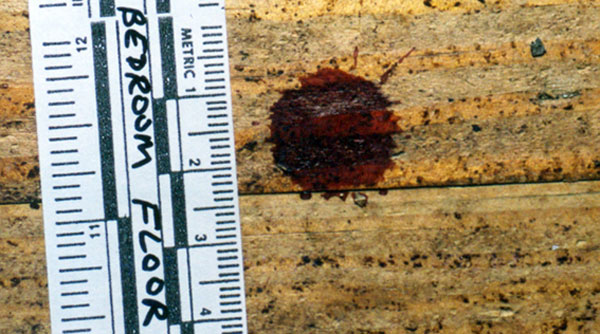
Passive bloodstain on a wooden floorboard. (Courtesy of John Black, Ron Smith & Associates)
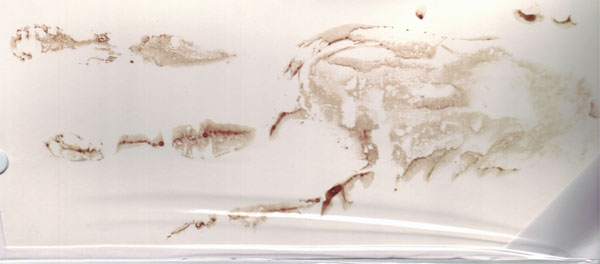
Transfer pattern made by a bloody hand. (Courtesy of John Black, Ron Smith & Associates)
Blood spatter is categorized as impact spatter (created when a force is applied to a liquid blood source) or projection spatter (caused by arterial spurting, expirated spray or spatter cast off an object). The characteristics of blood spatter depend on the speed at which the blood leaves the body and the type of force applied to the blood source.
Gunshot spatter - includes both forward spatter from the exit wound and back spatter from the entrance wound. Gunshot spatter will vary depending on the caliber of the gun, where the victim is struck, whether the bullet exits the body, distance between the victim and the gun and location of the victim relative to walls, floors and objects. Typically, forward spatter is a fine mist and back spatter is larger and fewer drops.
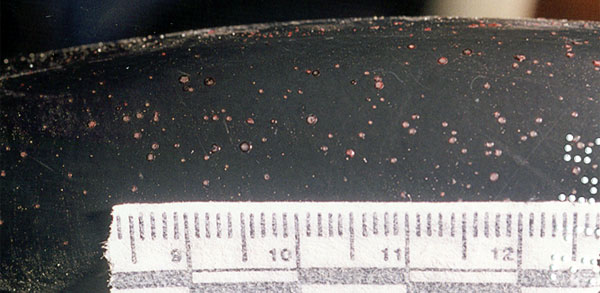
Back spatter from a gunshot wound on a steering wheel. (Courtesy of John Black, Ron Smith & Associates)
Cast-off - results when an object swung in an arc flings blood onto nearby surfaces. This occurs when an assailant swings the bloodstained object back before inflicting another blow. Analysts can tell the direction of the impacting object by the shape of the spatter (tails point in the direction of motion). Counting the arcs can also show the minimum number of blows delivered.
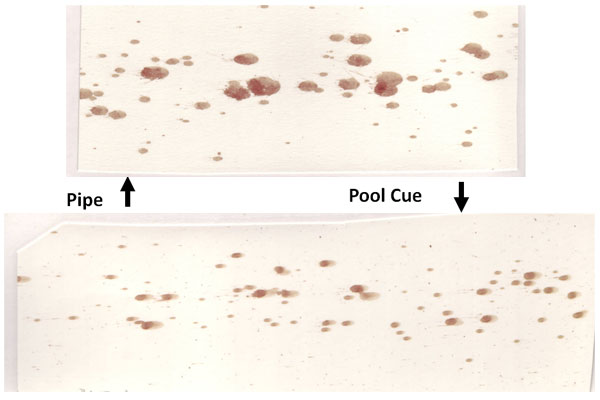
Cast-off spatter patterns from a pipe and a pool cue. (Courtesy of Brian Dew, Ron Smith & Associates)
Arterial spray - refers to the spurt of blood released when a major artery is severed. The blood is propelled out of the breached blood vessel by the pumping of the heart and often forms an arcing pattern consisting of large, individual stains, with a new pattern created for each time the heart pumps.
Expirated spatter - is usually caused by blood from an internal injury mixing with air from the lungs being expelled through the nose, mouth or an injury to the airways or lungs. Expirated spatter tends to form a very fine mist due to the pressure exerted by the lungs moving air out of the body. Small air bubbles in the drops of blood are typically found in this type of spatter.
Some bloodstains are latent, meaning they cannot be seen with the naked eye. Investigators can use chemical reagents such as Luminol to find and photograph latent bloodstains. When sprayed on blood, Luminol creates a bright blue luminescent glow by reacting with iron in the blood’s hemoglobin.
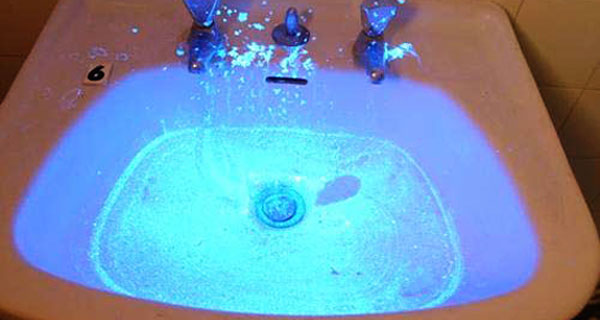
Luminol reveals latent bloodstains left on a sink. (Courtesy of John Black, Ron Smith & Associates)
Bloodshed Events
A crime scene where bodily injury has occurred is likely to have some amount of bloodstain evidence present; however, the amount will vary depending on the circumstances of the crime. The type of injury inflicted and the amount of force used will determine the volume and pattern of bloodstains:
- Sharp force injuries (stabbing) - these injuries are caused by an object with a relatively small surface area, such as an ice pick or a knife. Less blood is deposited on the instrument, resulting in a smaller, more linear pattern of stains.
- Blunt force injuries (hitting or beating) - objects inflicting this type of injury are usually larger, such as a bat or hammer. If the object impacts liquid blood, the larger surface area will collect more blood, producing drops of varying sizes.
- Gunshot injuries - mist-like spatter caused by bullets entering and exiting the body.
Interpreting the Patterns
When blood is impacted, droplets are dispersed through the air. When these droplets strike a surface, the shape of the stain changes depending on the angle of impact, velocity, distance travelled and type of surface impacted. Generally, the stain shape will vary from circular to elliptical, with tails or spines extending in the direction of travel. Smaller satellite stains may also break away from the initial drop. By measuring the width and length of the stain, the angle of impact can be calculated, helping investigators determine the actions that may have taken place at the scene.
As the angle of impact changes, so does the appearance of the resulting stain. A blood drop striking a smooth surface at a 90° angle will result in an almost circular stain; there is little elongation, and the spines and satellites are fairly evenly distributed around the outside of the drop. Below 75°, spines begin to become more prominent on the side of the spatter opposite the angle of impact. As the angle of impact decreases, the spatter stain elongates, becoming more elliptical, and the spines, etc., become more predominant opposite the angle of impact. At very low (acute) angles, a single satellite may break off to form a second stain; this is the distinctive “exclamation point” stain.
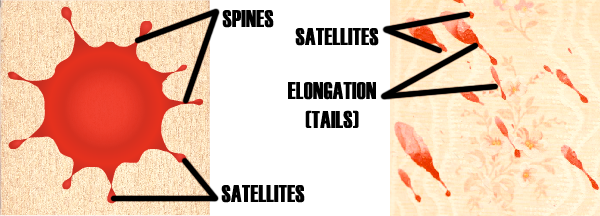
Void Patterns
A void occurs when a person or object blocks the path of the blood. They are important because voids can show investigators if objects are missing from the scene, where a person or persons were at the time of the incident, and if a body was moved. An object that leaves a void in a bloodstain pattern will have a matching bloodstain pattern on its surface, allowing analysts to replace it in the scene if found. Void patterns are most useful for establishing the position of the victim(s) and assailant(s) within the scene.